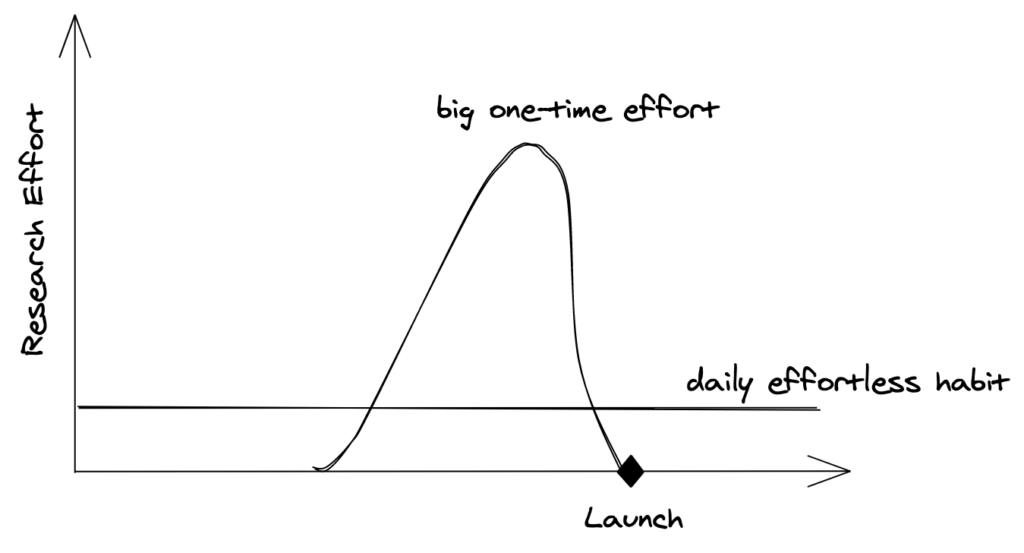“When are you planning to launch?” I asked my client on Zoom.
He had asked me to write a sales page for his online course.
“In two weeks… Why are you smiling?”
Ugh, I hate to be the party pooper, destroying ambitious launch plans.
As I explained what we had to do to keep the Stripe notifications coming, I saw a sudden realization sink in:
We should have started working on this months ago!
I get that you want to launch your new product or service ASAP. The earlier you put it out there, the faster you’re going to earn money, right?
All you have to do is hire a copywriter. They will magically conjure up messages for your website or sales page that make your prospects pull out their credit cards as if under some kind of love spell.
That’s not how it works, unfortunately. But don’t worry, I got you covered.
Where high-converting messages come from
The messages that make the biggest difference on your sales page or website don’t come from a copywriter or the inside of your head. They come directly from your audience.
Now, you might argue: “I know what I’m selling. I just have to explain it to my customers.”
The thing is, you aren’t actually selling a product or service…ever.
What you’re really selling to your prospects is a better version of themselves. A version that’s healthier, happier, gets more done, looks good in front of their boss, feels comfortable in their body, or shows up confidently in the next meeting.
You need to understand what their “better version” of themselves looks like. But when you stay in your own head, you only know what happiness means to you. It might be totally different for them.
Only the people who have already bought or are likely to buy your solution can tell you what they really care about. When you know that, you can mirror it back to them on your website and sales pages with the exact words they use. Suddenly, they’ll feel like you’re reading their mind.
By joining the conversation that’s already happening inside their heads, you’re showing them that you “get” what’s going on in their life. And what happens if we meet someone who naturally seems to understand us and our struggles? We feel a sense of connection and are much more open to what this person has to say.
Ultimately, that means your prospects are more likely to be glued to the page and convert into paying clients.
So, how do you uncover these messages? You guessed it, customer research. But isn’t this a lot of work?
Why we’ve been approaching customer research all wrong
So far, we’ve determined that it’s critical to uncover what your customers are thinking before putting words on the page. When you internalize this principle, you’re already way ahead of most business owners.
Still, many will take the easier route of writing what comes to their mind because they believe customer research takes a lot of work. And that’s true when you approach it the way most businesses do.
Most will start research only once they desperately need the input.
Just before a launch, you or your copywriter have to get to work to pull together the insights in a matter of days. That means sending out surveys, setting up interviews, scouring the internet for insightful reviews, and searching your emails for this one message from six months ago where your client voiced her concerns about your online course. It’s a BIG effort.
The problem is that most customers don’t answer surveys even when you offer an incentive. Think about it: How much do you care about filling out a questionnaire from a company? Let me guess: z-e-r-o. Customers are also reluctant to be interviewed. And you’ve long forgotten about the insightful messages and conversations you’ve had with your clients.
The result? You have nothing or very little to work with, end up guessing what to put on the page, and are less than thrilled with the results.
But there’s a better way.
The painless approach to customer research

What sparked this idea is my journey of improving my writing and publishing regularly.
The Write of Passage course taught me to approach writing online in a new way. It’s called writing from abundance. I leverage the time I already spend consuming information online and actively capture what stands out. Instead of starting every article from scratch, I can draw from a vast collection of notes and insights. When I actually sit down to write, the article is as much as 80% done already. Writing feels effortless and not like “work” anymore.
The same principle applies to customer research. First, you have to realize that you’re already doing most of the work.
Every time you’re speaking to a prospect or client, it’s customer research. Every time you’re looking at a competitor’s website, it’s customer research. And every time you’re helping someone in a Facebook or LinkedIn group with a question in your area of expertise, it’s customer research.
But, chances are you aren’t leveraging what you’re learning. There’s no way for you to easily recall these insights later. You’re racking your brain trying to remember what your client’s concern was with your online course. So, if you’re anything like me who can’t recall what she had for lunch two days ago, you’ll need a system to store it for you.
What if you’d capture all these insights into your customers at the moment you have them? And even automate collecting feedback from your customers? This would develop into an ever-growing library of insights, a gold mine for your business.
I see two major benefits here. One, what you learn can spark ideas for new products and services or prompt you to improve your existing solutions. Two, you and your copywriter can write better copy faster. All the messages are already there and just need to be combined the right way.
Customer research can transform from big, one-time efforts to a daily habit that feels (almost) effortless.
Sounds fantastic, Julia. But, how do you do this, practically speaking? Glad you asked. Click here to read all about the research habit.






